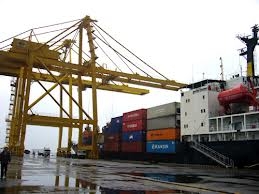Shippers facing turbulent seas
 Peter Smidt-Nielsen, general director of Maersk Line Vietnam & Cambodia Cluster, said for the rest of the year the market outlook did not look bright and Maersk Line would also be hit by a weak market outlook.
Peter Smidt-Nielsen, general director of Maersk Line Vietnam & Cambodia Cluster, said for the rest of the year the market outlook did not look bright and Maersk Line would also be hit by a weak market outlook.
“Maersk Line in Vietnam has so far this year been growing slightly. Going forward we want to maintain our market share, but it is crucial to increase our rates, as the current rates are not sustainable for any shipping line,” he said.
A representative from Ho Chi Minh City-based First Logistics Development - a Singapore-Vietnam joint venture, said: “We are experiencing an unprecedented hard time. We have to slash costs by 10 per cent and are possible of cutting workforce in the coming time.”
“Now is the time of common difficulties for both shipping businesses and port operators, and we are facing a severe competition,” she said. “Our company is trying to maintain operations in Vietnam and will not expand operations in the country in the coming time.”
Meanwhile, Do Xuan Quynh, general secretary of Vietnam Shipowners’ Association (VSA), said more participation and expansion of foreign shipping companies in domestic and international routes have exhausted of domestic shipping lines and many Vietnam firms are struggling for survival.
“Only shipping businesses with strong financial capabilities can keep alive their fleet,” he stressed.
According to Quynh, only about 8-10 per cent of Vietnamese exports were currently transported by domestic shipping lines while foreign ship owners dominate more than 90 per cent of Vietnam’s shipping market. Noticeably, 100 per cent of container goods is handled by foreign vessels. For this reason, foreign shipping lines have teamed up to push up freight loads, causing difficulties for Vietnamese exporters and importers.
“The shipping market will go on with numerous hardships in the remaining months of 2012 and in 2013, even in the market segmentation of dry cargo carrying ships that is strong point of Vietnam,” Quynh said.
Meanwhile, Nguyen Canh Viet, general director of state-run Vinalines, said many ship-owners had been seeking to sell their vessels even with prices much lower than buying prices.
“The year of 2012 is still very hard for shipping businesses,” Viet said.
Nguyen Kim Chinh, chairman of Haiphong city-based Tan Binh Co.Ltd., a private shipping line, also predicted the shipping sector would be difficult until the end of 2013 and only a modest recovery would be possible in 2014.
“We have been strenuous to be able to maintain stable operations. We have constantly changed our business strategy and have been flexible with every situation,” Chinh noted. In order to improve Vietnam’ shipping sector, Peter Smidt-Nielsen of Maersk Line said the country should improve inland infrastructure links from/to seaports as well as belt ways connecting major industrial areas. In particular high-capacity access roads to port areas are needed to cope with the increasing container movements.
In addition, he said, Vietnam should review port dues charged to the shipping lines to increase Vietnam’s competitiveness against other South-East-Asian ports to attract more additional international transit volume, ease transit procedures for containers and cargoes exported from a Vietnamese port but transited in another Vietnamese port before going onto final vessel.
Dredging maintenance and channel upgrades would help terminals in Haiphong, Ho Chi Minh, Cai Mep-Thi Vai serve larger vessels and reduce long-term costs. “Lastly, Vietnam should allow foreign shipping lines to transship full and empty containers in the country,” Smidt-Nielsen said. “Otherwise, Vietnam is just losing this income opportunity.
What the stars mean:
★ Poor ★ ★ Promising ★★★ Good ★★★★ Very good ★★★★★ Exceptional
Related Contents
Latest News
More News
- Global partnerships key to Vietnam’s IFC development (December 26, 2025 | 16:18)
- Vingroup pulls out of bid to invest in North-South high-speed railway (December 26, 2025 | 11:42)
- Strengthening supply chains through trade promotions and customs reform (December 24, 2025 | 14:00)
- PM orders investment model for North–South high-speed rail (December 22, 2025 | 17:43)
- LS Eco Energy to invest in Vietnam rare earth sector (December 22, 2025 | 17:31)
- Government moves to establish International Financial Centre (December 21, 2025 | 21:00)
- Vietnam's IFC to target global investment flows (December 21, 2025 | 18:00)
- Two national hospitals expand capacity with new facilities (December 20, 2025 | 09:00)
- Ha Tinh breaks ground on major Vingroup industrial and energy projects (December 19, 2025 | 18:24)
- EVN launches major power infrastructure projects nationwide (December 19, 2025 | 18:17)

 Tag:
Tag:





















 Mobile Version
Mobile Version